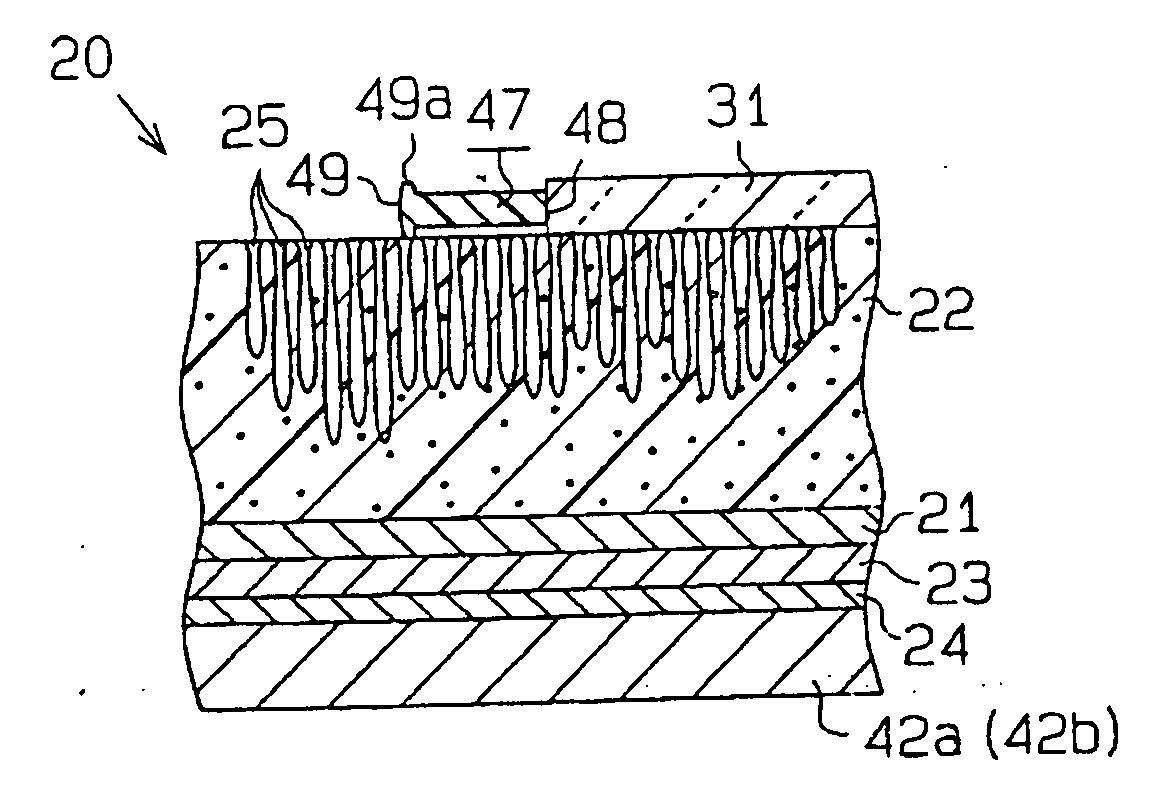Polishing pad, method of manufacturing glass substrate for use in data recording medium using the pad, and glass substrate for use in data recording medium obtained by using the method
a technology of data recording medium and polishing pad, which is applied in the direction of abrasive surface conditioning devices, instruments, lapping machines, etc., can solve the problems of frequent replacement of polishing pads, damage to the head, and damage to magnetic disks, so as to maintain the process yield of glass substrate, increase the manufacturing quantity of glass substrate, and improve the effect of quality
- Summary
- Abstract
- Description
- Claims
- Application Information
AI Technical Summary
Benefits of technology
Problems solved by technology
Method used
Image
Examples
example 1
[0056] The polishing portion 22 was formed of a polyurethane having a 100% modulus of 8.83 MPa (90 kgf / cm2), and thus the soft pad 20 was prepared to obtain the polishing pad of Example 1. Then, the soft pad 20 was subjected to the dressing treatment in which the Ra and Rmax values of the surface of the polishing part 22 were respectively made to be 7 μm or less and 60 μm or less. The 100% modulus was derived as follows: the strength of a specimen made of the polyurethane was measured by use of an autograph when elongated by 100% at room temperature from its length prior to measurement and the 100% modulus was obtained by dividing the strength thus obtained by the sectional area existing at the time of the measurement. The Ra and Rmax values of the surface of the polishing portion 22 were measured by means of an SE3400 manufactured by Kosaka Laboratory Ltd. under setting conditions in which the stylus diameter was 20 μmf, the measurement length was 25 mm, the measurement speed was 0...
example 2
[0058] The polishing portion 22 was formed of a polyurethane having a 100% modulus of 11.8 MPa, and thus the soft pad 20 was prepared to obtain the polishing pad of Example 2. Then, a soft pad which had the same Ra and Rmax values as that in Example 1 was obtained without applying the dressing treatment. By using the soft pad 20, similarly to Example 1, the surfaces of plural sheets of glass workpieces 31 were polished to prepare glass substrates. In this case, the load exerted by the soft pad 20 on the glass workpieces 31 and the product of the load (gf / cm2) and the polishing period time (minutes) were set to be the same as those in Example 1. The obtained glass substrates had an average NRa value of 0.25 nm with an accompanying standard deviation of 0.05. The lifetime of the soft pad 20 was measured to be 125 hours.
example 3
[0059] The polishing portion 22 was formed of a polyurethane having a 100% modulus of 11.8 MPa, and thus the soft pad 20 was prepared to obtain the polishing pad of Example 3. Then, a soft pad which had the same Ra and Rmax values as that in Example 1 was obtained by applying the dressing treatment. By using the soft pad 20, similarly to Example 1, the surface of plural sheets of glass workpieces 31 was polished to prepare glass substrates. The obtained glass substrates gave the average NRa value of 0.20 nm with the accompanying standard deviation of 0.05. In this case, the product between the load exerted by the soft pad 20 to the glass workpieces 31 and the product between the load (gf / cm2) and the polishing period of time (minutes) were set to be the same as those in Example 1. The lifetime of the soft pad 20 was measured to be 125 hours.
PUM
| Property | Measurement | Unit |
|---|---|---|
| surface roughness | aaaaa | aaaaa |
| Ra | aaaaa | aaaaa |
| particle size | aaaaa | aaaaa |
Abstract
Description
Claims
Application Information
 Login to View More
Login to View More - R&D
- Intellectual Property
- Life Sciences
- Materials
- Tech Scout
- Unparalleled Data Quality
- Higher Quality Content
- 60% Fewer Hallucinations
Browse by: Latest US Patents, China's latest patents, Technical Efficacy Thesaurus, Application Domain, Technology Topic, Popular Technical Reports.
© 2025 PatSnap. All rights reserved.Legal|Privacy policy|Modern Slavery Act Transparency Statement|Sitemap|About US| Contact US: help@patsnap.com


